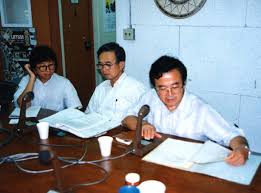

After the end of the Cold War, the United States left the Pacific with a mountain of projects that had lost their masters.
One of them was an educational and welfare network using second-hand satellites.
In 1991 I had two request projects on my desk. One was for a policy meeting regarding a satellite experiment project called PEACESAT which was being promoted by the University of Hawaii. The other was a request from the University of the South Pacific, headquartered in Fiji, for upgrading in distance education using satellites.
The competition between the U.S. and the Soviet Union intensified during the Cold War in the area of space development, when President Kennedy's 1961 Presidential Proclamation on Space Communications led to the launch of Intelsat, a satellite communication service covering the entire world. U.S. satellite development went even further, and, in 1971, a free communication service using second-hand satellites connected the islands which spread vast of the Pacific Ocean. This was PEACESAT, and at the same time, the University of the South Pacific's distance education communication, USPNet, was born. I was involved in both of these projects and wrote about the results in my second master's thesis and first PhD dissertation.
PEACESAT was led by the University of Hawaii in the U.S., while USPNet was led by the Commonwealth i.e. UK. The university structures and communication regulations were completely different, causing dissonance from the beginning.
The University of the South Pacific wanted to build its own network using stable commercial satellites rather than a second-hand, unstable, free satellite service which was monitored by the United States. Their request also included regulation reform of the monopoly telecommunications services in the Pacific island countries at that time.
If PEACESAT could be strengthened, it would benefit Micronesia, which is not covered by the University of the South Pacific. In the end, I lobbied Hon. Iremia Tabai of Kiribati, the PIF Secretary General, to support USPNet, which was the centerpiece of the first Pacific Island summit hosted by the Japanese government in 1997.
It was a big task, but in a sense I had abandoned Micronesia. The faces of Palau's President Nakamura and Minister of Education Billy Kuarei come to mind. So, with the advice of Prof. Akio Watanabe, I began working on telecommunications reform in the Micronesia as a concrete measure within the framework for sub-regional cooperation of Micronesia, since 1999. Next year, 2000, at the Okinawa G8 summit, so called the "IT Charter", a proposal for ICT support with 15 billion USD, was adopted.
A few months before the Okinawa G8 summit, the second Pacific Island summit was held in Miyazaki Prefecture. President Nakamura of Palau, who was the PIF chairman at the time, participated in this summit as co-chair. Japan's chairman was Prime Minister Mori.

In February 1992, I was the one who decided to support the PEACESAT policy making conference at Tohoku University, and UH were awarded a grant of about 25 million yen. In addition, Professor Shoichi Noguchi of Tohoku University requested the Ministry of Posts and Telecommunications to obtained another 25 million yen. The total cost of the conference was 50 million yen. As many as 300 people from Pacific island countries, including the U.S. and Australia, attended the conference in Sendai, where snow was falling. After the conference, I launched Pacific Islands Information and Communication Study group and conducted a field survey with Prof. Toshio Kosuge and Prof. Masatomo Tanaka of the of the University of Electro-Communications. (The author is on the left of the photo.) This study group result led to the USPNet upgrade project, which became a Japan-NZ-Australia cooperative ODA project.